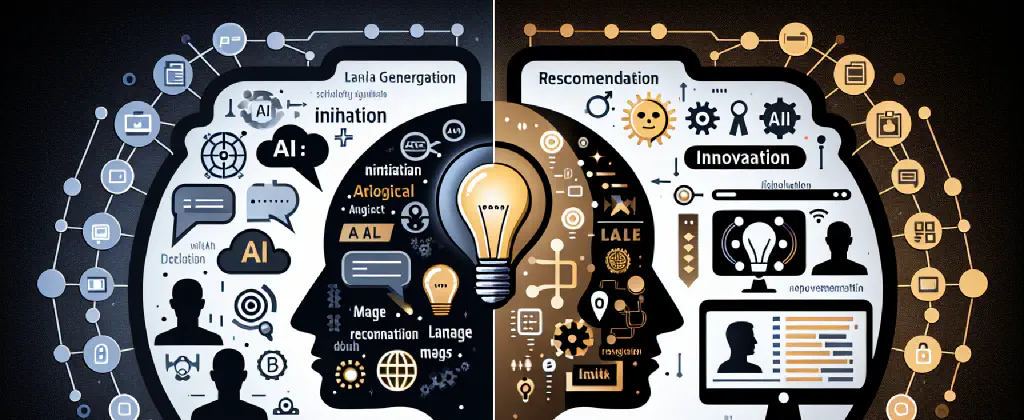13. December 2023
Artificial Intelligence: A Powerful Imitator, an Aspiring Innovator

Artificial intelligence (AI) systems have made remarkable strides in recent years, excelling at tasks such as language generation, image recognition, and recommendation systems. However, a debate arises when it comes to their ability to innovate. While some argue that AI can only imitate and lacks true innovation, others see the potential for AI to become an innovative force. In this article, we’ll explore key insights from experts and users to delve into the capabilities of AI systems for imitation and innovation.
The Power of Imitation
Language models, such as Large Language Models (LLMs), have shown great proficiency in composition. They can glue together pieces of knowledge in ways that were not done before, generating new compositions that impress humans. For example, a program using a specific language or a painting that combines two distinct themes. Most knowledge-based tasks performed by humans involve composition rather than innovation. We, as knowledge workers, are often engaged in composing information and ideas. In this aspect, LLMs can be considered as fair competitors.
The Importance of Plausibility
Human judgments of composition tend to favor recall over precision. We find sense and justification in something generated if it is plausible, even if not completely precise. This preference for plausibility means that LLMs, which can generate compositions with some level of coherence, have the potential to be valuable tools. While they may not be completely innovative, their ability to compose information can be leveraged effectively. However, LLMs could benefit from a parameter that balances recall and precision, allowing the adjustment of their output.
The Role of Randomness in Innovation
Innovation is often associated with the combination of composition and random generation. It is through these elements that new ideas can emerge. Some argue that all innovation involves both generating new ideas and transforming existing knowledge through composition. LLMs, although not yet on par with human innovators, have a rudimentary form of innovation. They can combine existing knowledge in novel ways, showcasing potential for further development in this area.
The Illusion of Randomness
Human creativity and innovation may not be as random as we perceive them to be. Our brains, acting as functions, receive input in the form of existing knowledge, including genetic and learned knowledge. The output of our “innovation” operation results in novel ideas, which, by logic, must include components that are randomly generated, albeit within the realm of possibility. While LLMs may not possess the same depth of experience as humans, they can generate output that appears human-like in terms of language and communication. The question of whether LLMs can truly feel emotions or innovate remains unanswered, challenging our assumptions about human and AI capabilities.
The Limitation of Training Data
The volume and variety of training data play a crucial role in the potential for innovation. Humans are exposed to a wide range of stimuli, including text, images, feelings, emotions, sounds, and smells. This rich experiential data serves as a source for human innovation. On the other hand, LLMs are limited to training solely on textual data, lacking the depth and breadth of human experiences. This limitation suggests that LLMs may face challenges in generating truly innovative ideas that extend beyond the boundaries of their training data.
Striving for Innovation
While AI systems excel at imitation, the ability to innovate is a more complex endeavor. Innovation involves introducing something new that offers value or improvement. The current generation of AI systems, driven by past input, may struggle to achieve true innovation. However, researchers and developers are actively exploring ways to enhance AI systems and imbue them with reasoning abilities to enable more innovative outputs. By incorporating reasoning and expanding the capabilities of AI models, the potential for generating truly novel and valuable ideas can be unlocked.
Setting the Bar for AI Evaluation
Evaluating AI progress can be a matter of perspective. Some express disappointment that AI systems are unable to innovate, focusing solely on their imitative abilities. However, it is crucial to acknowledge the astounding advancements AI has made in a short period. Rather than changing the goalposts of evaluation, we should recognize the vast potential AI possesses to approximate human-level capabilities. As we reach goals initially thought unattainable, it becomes an opportune time to set new goals that push the boundaries of innovation.
In conclusion, while AI systems have shown tremendous aptitude in imitation, their capacity for innovation remains a subject of debate. LLMs excel in composition, generating new combinations of knowledge, but their ability to truly innovate is still developing. The interplay between composition and random generation is seen as a fundamental aspect of innovation, an area where AI systems are making strides. Balancing the limitations of training data and expanding the reasoning capabilities of AI models could unlock their full potential as innovative tools. As we navigate the evolving world of AI, it is important to appreciate both its strengths in imitation and its growing potential for innovation. After all, as the saying goes, “Everything is a remix.”